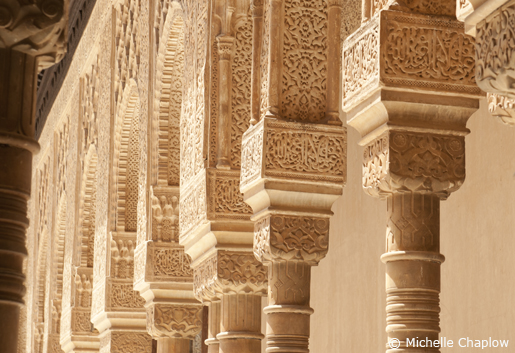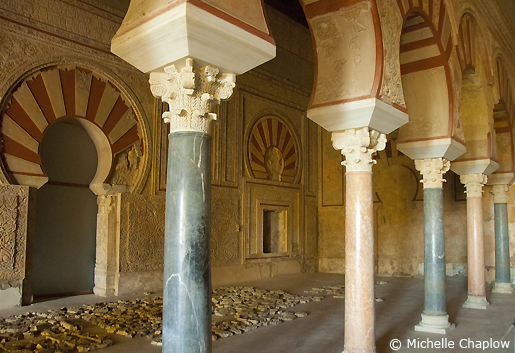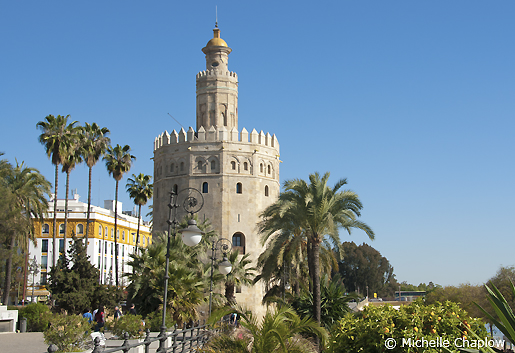 |
| The epitome of the patio andaluz is the Patio de los Leones. |
Muslim Architecture
The horseshoe arch, first seen in small churches erected by the Visigoths, was developed by the Moors and became the hallmark of their architecture; the Grand Mosque in Córdoba being the classic and most well known example. Other design characteristics brought from Syria by the Umayyads in the 8th century were plant motifs and decorative inscriptions of calligraphy running horizontally across walls or around doorways.
 |
| Plant motifs and decorative inscriptions of calligraphy running horizontally across walls in the Alhambra. |
Brickwork in relief was also used as a form of ornamentation and the alternating of red and white brick keystones were common in arches as were the blind arcades over doors. Much of this can be seen at the vast palace-city of Medina Azahara, just outside Córdoba. Built in the 10th century, only about ten per cent of it has so far been excavated.
 |
| Arches in the vast palace-city of Medina Azahara. |
The architectural style of Almohads, who ruled during the 12th and 13th centuries, was plainer. They used wide bands of raised brick for decoration, as in the Giralda in Sevilla, all that remains of the Aljama Mosque. And the traditional rounded arches became more pointed, as seen in the Torre del Oro, also in Sevilla.
 |
| The traditional rounded arches became more pointed, as seen in the Torre del Oro. |
Arranging suites of rooms around a central courtyard with fountains and garden was a key feature of Moorish architecture and it has continued to this day throughout Andalucía. The epitome of the patio andaluz is the Patio de los Leones in the Alhambra at Granada, and they can be seen in most of the ancient palaces, mansions and fortresses. It is also a significant feature of private houses and of many official buildings, such as the Reales Alcázares, a group of palatial buildings in Sevilla. In Córdoba a Festival of the Patios takes place in May every year.
Water was brought into palaces and mansions and also taken to the fields for irrigation by a complex system of channels created by the Moors whose agricultural architecture was unparalleled. There is a water wheel still visible in the small town of Pozo de los Frailes near Cabo de Gata (Almería), and another at Alcolea del Río on the Guadalquivir river which was used in the Peña de la Sal flour mill.
The use of public baths formed a focal part of Moorish daily life and those in Jaén, in the basement of the Palacio de Villardompardo, are the largest to have been discovered in Europe. Ronda also has a fine example, situated on the Tajo river, and in Alhama de Granada the Moors developed the baths created by the Romans over a warm spring, building their own magnificent horseshoe arches on top of the remains and covering the whole with a vaulted roof pierced by star-shaped apertures to let daylight filter through.
An alcázar or fortress was an essential part of every centre settled by the Moors. Some were mere lookout towers; others contained a palace or a whole city. For exceptional examples, go to the cities of Málaga or Carmona, Jaén or Almería. But the quintessential palace-fortress-city is the Alhambra in Granada. Constructed by the Nasrids, who reigned from there in the 14th and 15th centuries, it is considered the finest expression of urban Moorish architecture in Europe.